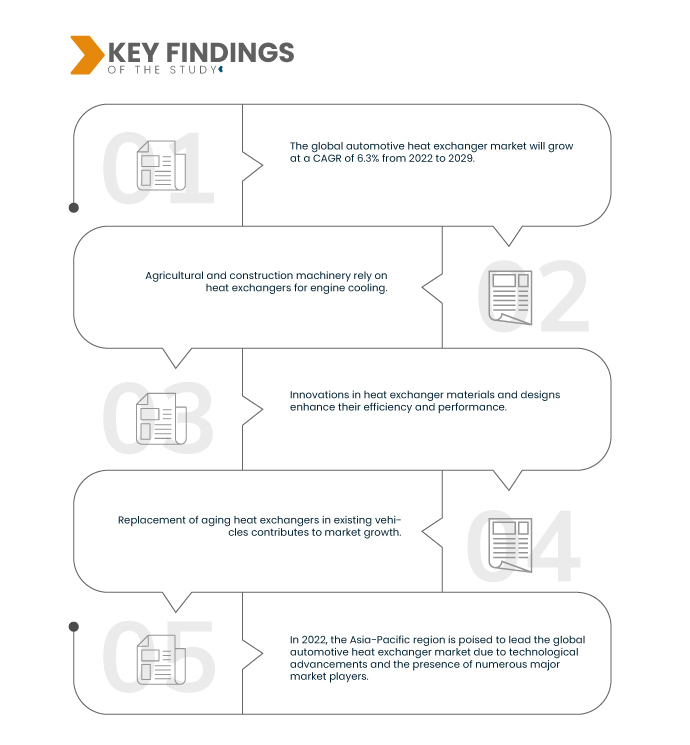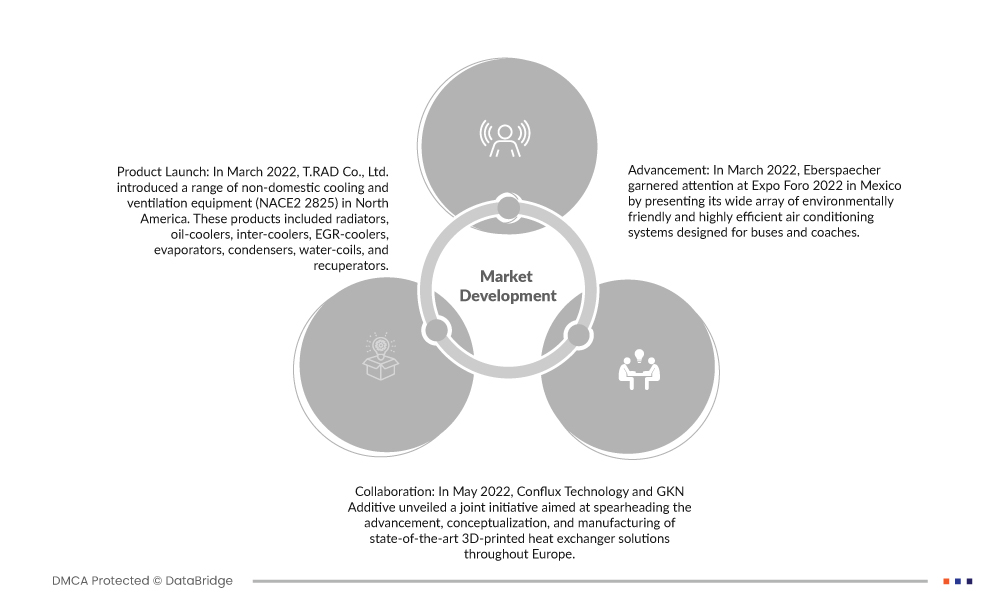Le marché des échangeurs de chaleur pour l'automobile répond à diverses applications de l'industrie automobile. Il joue un rôle crucial dans la gestion de la température du moteur, l'optimisation des systèmes CVC et l'amélioration de l'efficacité globale du véhicule. Parmi ces applications, le segment dominant est celui des systèmes de refroidissement moteur. Les échangeurs de chaleur moteur sont des composants essentiels pour maintenir des températures de fonctionnement optimales du moteur et en garantir la longévité et les performances. Face aux exigences croissantes en matière de consommation de carburant et de contrôle des émissions, les systèmes de refroidissement moteur restent une priorité, stimulant la croissance du marché des échangeurs de chaleur pour l'automobile.
Accéder au rapport complet sur https://www.databridgemarketresearch.com/reports/global-automotive-heat-exchanger-market
Data Bridge Market Research estime que le marché mondial des échangeurs de chaleur pour l'automobile connaîtra un TCAC de 6,3 % entre 2022 et 2029. L'augmentation de la production automobile mondiale et du nombre de véhicules fabriqués se traduit par une demande accrue d'échangeurs de chaleur. Ces composants essentiels font partie intégrante des systèmes de gestion thermique des véhicules, notamment les systèmes de refroidissement du moteur et de CVC, garantissant des performances optimales et le respect des réglementations en matière d'émissions. Cette tendance de croissance est portée par l'expansion de l'industrie automobile et la nécessité de maintenir l'efficacité et la fiabilité des véhicules.
Principales conclusions de l'étude
Le contrôle climatique devrait stimuler le taux de croissance du marché
Les attentes croissantes des clients en matière de confort et de climatisation dans les véhicules favorisent l'adoption d'échangeurs thermiques. Les systèmes CVC avancés nécessitent des échangeurs thermiques performants pour réguler efficacement la température de l'habitacle. Les consommateurs recherchent des fonctionnalités avancées, comme un refroidissement ou un chauffage plus rapide, une distribution d'air homogène et une consommation d'énergie réduite. Par conséquent, les constructeurs automobiles intègrent des technologies d'échangeurs thermiques sophistiquées pour répondre à ces exigences, favorisant ainsi une utilisation et une innovation accrues dans ce segment de l'industrie automobile.
Portée du rapport et segmentation du marché
Rapport métrique
|
Détails
|
Période de prévision
|
2022 à 2029
|
Année de base
|
2021
|
Années historiques
|
2020 (personnalisable de 2014 à 2019)
|
Unités quantitatives
|
Chiffre d'affaires en millions USD, volumes en unités, prix en USD
|
Segments couverts
|
Application (refroidisseur intermédiaire, radiateur, climatisation, refroidisseur d'huile et autres), type de conception (ailette tubulaire, barre de plaque et autres), matériau (aluminium, cuivre et autres), type de propulsion (moteur à combustion interne (ICE) et véhicule électrique (VE)), type de véhicule (voiture de tourisme, véhicule utilitaire léger et véhicule utilitaire lourd).
|
Pays couverts
|
États-Unis, Canada et Mexique en Amérique du Nord, Allemagne, France, Royaume-Uni, Pays-Bas, Suisse, Belgique, Russie, Italie, Espagne, Turquie, reste de l'Europe en Europe, Chine, Japon, Inde, Corée du Sud, Singapour, Malaisie, Australie, Thaïlande, Indonésie, Philippines, reste de l'Asie-Pacifique (APAC) en Asie-Pacifique (APAC), Arabie saoudite, Émirats arabes unis, Afrique du Sud, Égypte, Israël, reste du Moyen-Orient et de l'Afrique (MEA) en tant que partie du Moyen-Orient et de l'Afrique (MEA), Brésil, Argentine et reste de l'Amérique du Sud en tant que partie de l'Amérique du Sud.
|
Acteurs du marché couverts
|
Nippon Light Metal Company, Ltd. (Japon), T.RAD Co., Ltd. (Japon), Marelli Holdings Co., Ltd. (Japon), Nissens Automotive A/S (Danemark), Griffin Thermal Products (États-Unis), Valeo (France), Dana Limited (États-Unis), Hanon Systems (Corée du Sud), TYC Brother Industrial Co., Ltd. (Taïwan), Clizen Inc. (Corée du Sud), MODINE MANUFACTURING COMPANY (États-Unis), DENSO Corporation (Japon), MAHLE GmbH (Allemagne), Constellium (Pays-Bas), SANDEN CORPORATION (Japon), G&M Radiator (États-Unis), Mishimoto Automotive (États-Unis), AKG Group (Autriche), Banco Products (I) Ltd. (Inde), PWR Corporate (Australie)
|
Points de données couverts dans le rapport
|
Outre les informations sur les scénarios de marché tels que la valeur marchande, le taux de croissance, la segmentation, la couverture géographique et les principaux acteurs, les rapports de marché organisés par Data Bridge Market Research comprennent également une analyse approfondie par des experts, une production et une capacité géographiquement représentées par entreprise, des configurations de réseau de distributeurs et de partenaires, une analyse détaillée et mise à jour des tendances des prix et une analyse des déficits de la chaîne d'approvisionnement et de la demande.
|
Analyse des segments :
Le marché mondial des échangeurs de chaleur automobiles est segmenté en application, type de conception, type de véhicule matériel et type de propulsion.
- Sur la base de l'application, le marché mondial des échangeurs de chaleur automobiles est segmenté en refroidisseur intermédiaire, radiateur, climatisation, refroidisseur d'huile et autres.
- Sur la base du type de conception, le marché mondial des échangeurs de chaleur automobiles est segmenté en tubes à ailettes, barres à plaques et autres.
- Sur la base du matériau, le marché mondial des échangeurs de chaleur automobiles est segmenté en aluminium, cuivre et autres.
- Sur la base du type de propulsion, le marché mondial des échangeurs de chaleur automobiles est segmenté en moteur à combustion interne (ICE) et véhicule électrique (VE).
- Sur la base du type de véhicule, le marché mondial des échangeurs de chaleur automobiles est segmenté en voiture particulière, véhicule utilitaire léger et véhicule utilitaire lourd.
Acteurs majeurs
Data Bridge Market Research reconnaît les entreprises suivantes comme les acteurs mondiaux du marché des échangeurs de chaleur automobiles sur le marché mondial des échangeurs de chaleur automobiles sont Nippon Light Metal Company, Ltd. (Japon), T.RAD Co., Ltd. (Japon), Marelli Holdings Co., Ltd. (Japon), Nissens Automotive A/S (Danemark), Griffin Thermal Products (États-Unis), Valeo (France).
Évolution du marché
- En mars 2022, T.RAD Co., Ltd. a lancé une gamme d'équipements de refroidissement et de ventilation non domestiques (NACE2 2825) en Amérique du Nord. Ces produits comprenaient des radiateurs, des refroidisseurs d'huile, des refroidisseurs intermédiaires, des refroidisseurs EGR, des évaporateurs, des condenseurs, des serpentins à eau et des récupérateurs. Cette décision stratégique a permis à l'entreprise de diversifier son offre de produits et d'accroître son chiffre d'affaires en répondant aux divers besoins du marché nord-américain. En élargissant sa gamme de produits, T.RAD Co., Ltd. a également renforcé ses ventes et sa présence sur le marché nord-américain.
- En mai 2022, Conflux Technology et GKN Additive ont dévoilé une initiative commune visant à promouvoir le développement, la conceptualisation et la fabrication de solutions d'échangeurs de chaleur imprimés en 3D de pointe dans toute l'Europe. Ces échangeurs de chaleur imprimés en 3D démontrent leur potentiel pour révolutionner l'amélioration des performances de refroidissement dans des secteurs clés tels que l'électronique, l'automobile, l'aérospatiale, etc. Cette transformation est rendue possible grâce aux possibilités de conception créative offertes par la technologie d'impression 3D.
- En mars 2022, Eberspaecher a attiré l'attention à l'Expo Foro 2022 de Mexico en présentant sa large gamme de systèmes de climatisation écologiques et hautement performants, conçus pour les bus et les autocars. L'AC353 de cinquième génération était à l'honneur, un système de climatisation polyvalent monté sur le toit, conçu pour offrir des performances exceptionnelles dans diverses conditions climatiques. L'AC353-5 d'Eberspaecher bénéficie d'améliorations telles qu'un condenseur optimisé et un échangeur de chaleur optimisé, permettant des réductions substantielles du poids, de la consommation de réfrigérant (jusqu'à 15 %), de la consommation d'énergie et de carburant, ainsi qu'une amélioration globale de l'efficacité du système de climatisation.
Analyse régionale
Géographiquement, les pays couverts dans le rapport sur le marché mondial des échangeurs de chaleur automobiles sont les États-Unis, le Canada et le Mexique en Amérique du Nord, l'Allemagne, la France, le Royaume-Uni, les Pays-Bas, la Suisse, la Belgique, la Russie, l'Italie, l'Espagne, la Turquie, le reste de l'Europe en Europe, la Chine, le Japon, l'Inde, la Corée du Sud, Singapour, la Malaisie, l'Australie, la Thaïlande, l'Indonésie, les Philippines, le reste de l'Asie-Pacifique (APAC) en Asie-Pacifique (APAC), l'Arabie saoudite, les Émirats arabes unis, l'Afrique du Sud, l'Égypte, Israël, le reste du Moyen-Orient et de l'Afrique (MEA) dans le cadre du Moyen-Orient et de l'Afrique (MEA), le Brésil, l'Argentine et le reste de l'Amérique du Sud dans le cadre de l'Amérique du Sud.
Selon l'analyse de Data Bridge Market Research :
L'Asie-Pacifique devrait dominer le marché mondial des échangeurs de chaleur automobiles au cours de la période de prévision 2022-2029
En 2022, la région Asie-Pacifique devrait dominer le marché mondial des échangeurs de chaleur pour l'automobile. Cette domination est due aux avancées technologiques de la région et à la présence de nombreux acteurs majeurs. Ces facteurs favorisent l'adoption croissante de produits et services d'échangeurs de chaleur pour l'automobile, répondant ainsi à la demande croissante de solutions de gestion thermique efficaces dans l'industrie automobile. Le dynamisme du secteur automobile en Asie-Pacifique la positionne à l'avant-garde de ce marché à l'échelle mondiale.
Pour plus d'informations sur le marché mondial des échangeurs de chaleur automobiles, cliquez ici : https://www.databridgemarketresearch.com/reports/global-automotive-heat-exchanger-market












